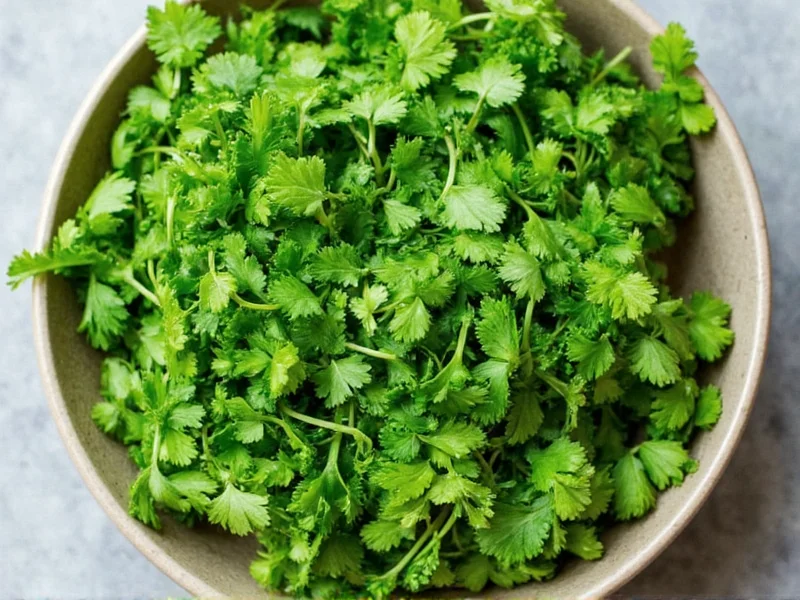Understanding herb conversions is essential for consistent cooking results. When substituting dried parsley for fresh in recipes, getting the measurements right prevents your dishes from becoming either bland or overpoweringly herbal. This guide explains not just the conversion ratio, but the science behind it and practical tips for perfect seasoning every time.
Why Dried and Fresh Parsley Require Different Measurements
Dried parsley contains significantly less moisture than fresh, concentrating its flavor compounds. Fresh parsley is approximately 85-90% water, while dried parsley has most of this moisture removed. This concentration means dried herbs deliver more intense flavor per volume. The standard culinary guideline of using one-third the amount of dried herbs compared to fresh applies specifically because of this moisture difference and increased potency.
The Complete Parsley Conversion Guide
| Measurement | Fresh Parsley | Dried Parsley |
|---|---|---|
| Teaspoon | 3 tsp | 1 tsp |
| Tablespoon | 1 tbsp | 1 tsp |
| Cup | 1 cup | ⅓ cup |
| Ounce | 1 oz (fresh) | 0.33 oz (dried) |
Factors That Affect the Standard Conversion Ratio
While the 3:1 ratio serves as a reliable starting point for how much dry parsley to fresh substitution, several factors may require adjustments:
- Herb quality - Older dried herbs lose potency over time, potentially requiring slightly more than the standard ratio
- Drying method - Commercially dried versus home-dried parsley may have different concentration levels
- Recipe type - Long-cooking dishes allow dried herbs more time to rehydrate and release flavor
- Personal preference - Some cooks prefer slightly stronger or milder herb flavors
Practical Tips for Perfect Herb Substitution
When converting between fresh and dried parsley in your recipes, follow these professional kitchen techniques:
- Add dried herbs early - Incorporate dried parsley at the beginning of cooking to allow time for rehydration and flavor development
- Add fresh herbs late - Stir fresh parsley in during the last few minutes of cooking to preserve its delicate flavor and color
- Taste and adjust - Always taste your dish before serving and adjust seasoning if needed
- Crush dried herbs - Rub dried parsley between your fingers before adding to release more flavor compounds
- Consider the dish type - For delicate dishes like fish or eggs, use slightly less dried parsley than the standard ratio
How Herb Age Affects Conversion Accuracy
Dried herbs gradually lose potency over time. Properly stored dried parsley maintains peak flavor for 1-2 years, while fresh parsley lasts 1-2 weeks refrigerated. When using older dried herbs, you might need to increase the amount by 25-50% beyond the standard conversion ratio. To test dried herb potency, rub a small amount between your fingers and smell - vibrant aroma indicates good potency, while faint scent suggests diminished strength.
Storage Tips for Maximum Herb Potency
Proper storage preserves the flavor intensity that makes accurate conversion possible:
- Fresh parsley - Store in a glass of water in the refrigerator, covered with a plastic bag for up to 2 weeks
- Dried parsley - Keep in airtight containers away from light, heat, and moisture for up to 2 years
- Freezing fresh parsley - Chop and freeze in oil for longer storage while maintaining better flavor than dried
- Label containers - Note purchase or drying dates to track freshness
Common Herb Conversion Mistakes to Avoid
Many home cooks make these errors when substituting dried for fresh parsley:
- Using equal amounts of dried and fresh herbs
- Adding dried herbs at the same stage as fresh in recipes
- Not accounting for the age of dried herbs
- Measuring dried herbs without breaking up clumps
- Using the same conversion ratio for all herbs (different herbs have varying concentration levels)
Conversion Ratios for Other Common Herbs
While parsley follows the standard 3:1 fresh-to-dried ratio, other herbs have slightly different conversion rates due to varying oil concentrations:
| Herb | Fresh to Dried Ratio | Notes |
|---|---|---|
| Parsley | 3:1 | Standard conversion ratio |
| Basil | 3:1 | Fragile fresh leaves lose significant volume when dried |
| Oregano | 4:1 | Dried oregano is significantly more potent than fresh |
| Thyme | 3:1 | Leaves are small both fresh and dried |
| Rosemary | 2:1 | Fresh rosemary is already quite potent |
When to Adjust Beyond Standard Parsley Conversion
Certain cooking situations warrant modifying the standard how much dry parsley equals fresh measurement:
- Long-simmering dishes - Reduce dried herb amount by 25% as extended cooking time intensifies flavor
- Raw applications - For salads or garnishes, use fresh parsley whenever possible as dried won't rehydrate properly
- Delicate sauces - Use slightly less dried parsley to avoid overpowering subtle flavors
- Strong-flavored dishes - In robust recipes like stews, you might increase dried herb amount by 10-15%











 浙公网安备
33010002000092号
浙公网安备
33010002000092号 浙B2-20120091-4
浙B2-20120091-4